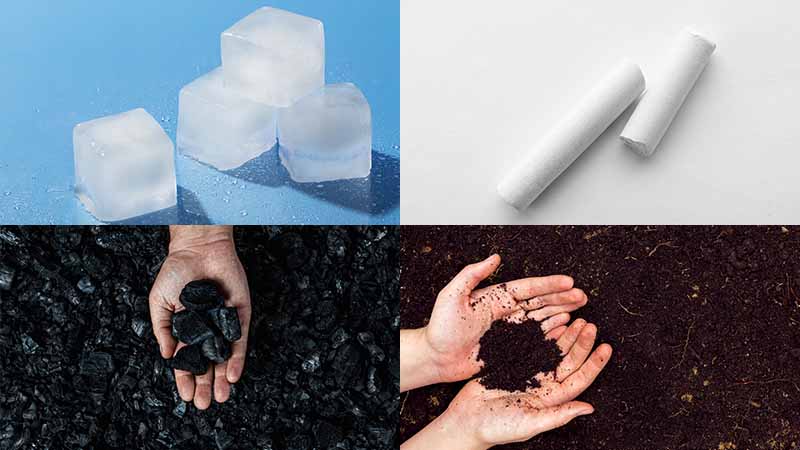PICA: Cravings For Non-Food Items! (Like Clay, Ice, Chalk, etc.)
- 19 months ago
Someone nibbling on chalk, munching on paper, or savoring the earthy taste of dirt. It sounds bizarre, right? Welcome to the peculiar world of Pica, an unusual eating disorder where people crave and consume non-food items.
Pica isn't just an odd eating habit; it's a unique disorder that prompts us to dig deeper. But it's not just about medical definitions. Pica offers a window into our minds, a way to explore why we crave what we crave, even when it's not food. It's a condition that doesn't discriminate – affecting kids, adults, and everyone in between.
It speaks of nutritional imbalances, whispers about emotional struggles, and hints at the impact of culture and surroundings. Pica invites us to question the boundaries of human behavior and the remarkable strength of those who face it.
Pica cravings include
People with pica often crave and ingest these substances, despite the potential health risks and lack of nutritional value. Some of them are:
- Burnt matches
- Chalk
- Charcoal
- Ice
- Cornstarch
- Toothpaste
- Soap
- Sand
- Plaster
- Baking soda
- Cigarette ashes
- Hair

Symptoms of Pica
Recognizing pica can be challenging due to the wide range of non-food items involved and variations in symptoms among individuals. Common signs and symptoms include:
- Persistent consumption of non-food substances
- Individuals with pica often find it exceedingly difficult to resist the urge to eat non-food items.
- Pica can lead to serious health issues, such as lead poisoning (from ingesting lead-based paint chips), intestinal blockages, infections, or dental problems.
- Especially in children, it can cause behavioral problems. Young children may eat inedible objects or items that pose a choking hazard.
- It can interfere significantly with daily life and cause emotional distress for individuals and their families.
Complications of Pica
Pica is not a harmless habit; it can have severe consequences for physical and psychological health. Some potential complications include:
- Toxicity: Ingesting certain non-food items can lead to poisoning or other toxic reactions, with symptoms ranging from nausea to seizures.
- Gastrointestinal problems: Swallowing non-food items can cause blockages, perforations, or other digestive issues that require surgical intervention.
- Dental damage: Chewing on non-food objects can lead to dental problems, such as chipped or broken teeth, which can be both painful and costly.
- Nutritional deficiencies: Pica can prevent individuals from obtaining essential nutrients, potentially resulting in anemia, malnutrition, or developmental delays, particularly in children.
- Infections: Consuming contaminated substances can lead to infections or parasitic infestations, adding to the overall health risks associated with pica.
How to manage pica?
Managing pica can be challenging, but with the right approach, individuals with this disorder can learn to control their impulses and reduce the associated health risks. Some strategies to manage are:
- Nutritional Assessment: If nutritional deficiencies are contributing to pica, a healthcare provider may conduct blood tests to identify any deficiencies and recommend appropriate dietary changes or supplements.
- Behavioral Therapy: Cognitive-behavioral therapy (CBT) has shown effectiveness in treating pica. This form of therapy helps individuals recognize and change the thought patterns and behaviors associated with pica. It can also teach coping strategies to manage cravings and compulsions.
- Medication: In certain cases, medical professionals may recommend drugs to treat underlying mental health issues that lead to it. For instance, medication may help manage the symptoms of anxiety or obsessive-compulsive disorder (OCD) if they are present.
- Environmental Modifications: Make changes to the environment to reduce access to non-food items. It can involve childproofing the home, securing dangerous items out of reach, and ensuring a safe and clean living space.
- Education and Awareness: Educate the individual with pica and their family about the risks associated with consuming non-food items. Understanding the potential health consequences can be a powerful motivator for change.
- Alternative Sensory Outlets: For some individuals, pica may be related to sensory-seeking behavior. Providing alternative ways to satisfy sensory needs, such as stress balls, fidget toys, or textured objects, can help reduce the compulsion to consume non-food items.
- Monitor and Record: Keep a record of when pica behaviors occur. Identifying patterns and triggers can provide insights into how to manage and prevent them.

FAQ's
Q: Who can develop pica?
A: Pica can affect individuals of all ages, but it is most commonly observed in children, pregnant women, and individuals with certain developmental or psychological disorders such as autism or intellectual disabilities.
Q: What causes pica?
A: The exact cause of pica is not well understood, but it is believed to be associated with a combination of factors including nutritional deficiencies, underlying psychological or emotional issues, and environmental influences.
Q: Is pica treatable?
A: Yes, pica is treatable, especially when identified and addressed early. With appropriate interventions and support, individuals with pica can learn to manage their cravings and avoid the consumption of non-food substances.
Conclusion
Pica is a rare and perplexing eating disorder that challenges our understanding of human cravings and behaviors. While it may seem bizarre, it's essential to recognize that individuals with pica often require understanding, support, and professional treatment to address the underlying causes and manage the condition effectively.
Disclaimer: “The purpose of the article is to inform and educate. It can no way be used as a substitute for medical diagnosis or treatment. Always consult your physician before making any significant diet, exercise or lifestyle changes”









